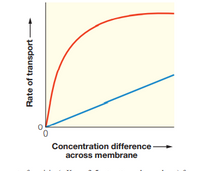
Biochemistry
9th Edition
ISBN: 9781319114671
Author: Lubert Stryer, Jeremy M. Berg, John L. Tymoczko, Gregory J. Gatto Jr.
Publisher: W. H. Freeman
expand_more
expand_more
format_list_bulleted
Question
One of the curves in this graph describes nonmediated diffusion, and theother describes facilitated transport. Which is which? Explain your choices.

Transcribed Image Text:Concentration difference
across membrane
Rate of transport -
Expert Solution
This question has been solved!
Explore an expertly crafted, step-by-step solution for a thorough understanding of key concepts.
This is a popular solution
Trending nowThis is a popular solution!
Step by stepSolved in 2 steps

Knowledge Booster
Learn more about
Need a deep-dive on the concept behind this application? Look no further. Learn more about this topic, biochemistry and related others by exploring similar questions and additional content below.Similar questions
- Give one way in which active transport differs from facilitated diffusionarrow_forwardFor each type of membrane transport, know the following:– Is a transporter protein required? If so, what type?– Is there an energy requirement, and if so, what is the energy source?– What is the relative rate of solute transport based on molecule type? On concentration gradient?– What are examples of the types of solutes transported by carriers and channels?arrow_forwardWhat are the distinctions between facilitated difussion, primary active transport and secondary active transport?arrow_forward
- what are the two types of facilitated diffusion and what is an example of each?arrow_forwardMolecules cannot move naturally through tje selmembrane against its diffusion gradient,but it does.Explain this statement critically using the sodium-potassium pump diagramarrow_forwardWhen a bacterial cell is placed in a hypotonic, environment, the cell wall restrains the pressure resulting from the greater osmolarity of the cytoplasm. (Use one word in the blank space. Spelling must be correct to earn the point. The word "osmotic" is NOT an answer that that will earn credit for this question; there is another word that is required.)arrow_forward
- Examine the graph presented here. Using your knowledge of how the processes work, label each curve as representative of either simple diffusion or facilitated diffusion. Explain how you determined which curve was which.arrow_forwardWhat is active transport? DESCRIBE the function of Na+/K+ ATPasearrow_forwardSelect the best option: In diffusion, substances move from areas of (greater) (lesser) to (greater) lesser concentrations.arrow_forward
- Statement 1: The direction of diffusion of a solute across a membrane is determined by its concentration gradient and always moves toward equilibrium. Statement 2: In passive transport, solutes move down the gradient from a region of low concentration to a region of high concentration. A Both statements are true. Both statements are false. C) Statement 1 is true. Statement 2 is false. Statement 1 is false. Statement 2 is true.arrow_forwardCan you help me to explain every question with these answer?arrow_forwardIn your own words, describe one similarity and one difference between diffusion via channels (like aquaporins) and facilitated diffusion.arrow_forward
arrow_back_ios
SEE MORE QUESTIONS
arrow_forward_ios
Recommended textbooks for you
 BiochemistryBiochemistryISBN:9781319114671Author:Lubert Stryer, Jeremy M. Berg, John L. Tymoczko, Gregory J. Gatto Jr.Publisher:W. H. Freeman
BiochemistryBiochemistryISBN:9781319114671Author:Lubert Stryer, Jeremy M. Berg, John L. Tymoczko, Gregory J. Gatto Jr.Publisher:W. H. Freeman Lehninger Principles of BiochemistryBiochemistryISBN:9781464126116Author:David L. Nelson, Michael M. CoxPublisher:W. H. Freeman
Lehninger Principles of BiochemistryBiochemistryISBN:9781464126116Author:David L. Nelson, Michael M. CoxPublisher:W. H. Freeman Fundamentals of Biochemistry: Life at the Molecul...BiochemistryISBN:9781118918401Author:Donald Voet, Judith G. Voet, Charlotte W. PrattPublisher:WILEY
Fundamentals of Biochemistry: Life at the Molecul...BiochemistryISBN:9781118918401Author:Donald Voet, Judith G. Voet, Charlotte W. PrattPublisher:WILEY BiochemistryBiochemistryISBN:9781305961135Author:Mary K. Campbell, Shawn O. Farrell, Owen M. McDougalPublisher:Cengage Learning
BiochemistryBiochemistryISBN:9781305961135Author:Mary K. Campbell, Shawn O. Farrell, Owen M. McDougalPublisher:Cengage Learning BiochemistryBiochemistryISBN:9781305577206Author:Reginald H. Garrett, Charles M. GrishamPublisher:Cengage Learning
BiochemistryBiochemistryISBN:9781305577206Author:Reginald H. Garrett, Charles M. GrishamPublisher:Cengage Learning Fundamentals of General, Organic, and Biological ...BiochemistryISBN:9780134015187Author:John E. McMurry, David S. Ballantine, Carl A. Hoeger, Virginia E. PetersonPublisher:PEARSON
Fundamentals of General, Organic, and Biological ...BiochemistryISBN:9780134015187Author:John E. McMurry, David S. Ballantine, Carl A. Hoeger, Virginia E. PetersonPublisher:PEARSON

Biochemistry
Biochemistry
ISBN:9781319114671
Author:Lubert Stryer, Jeremy M. Berg, John L. Tymoczko, Gregory J. Gatto Jr.
Publisher:W. H. Freeman

Lehninger Principles of Biochemistry
Biochemistry
ISBN:9781464126116
Author:David L. Nelson, Michael M. Cox
Publisher:W. H. Freeman

Fundamentals of Biochemistry: Life at the Molecul...
Biochemistry
ISBN:9781118918401
Author:Donald Voet, Judith G. Voet, Charlotte W. Pratt
Publisher:WILEY

Biochemistry
Biochemistry
ISBN:9781305961135
Author:Mary K. Campbell, Shawn O. Farrell, Owen M. McDougal
Publisher:Cengage Learning

Biochemistry
Biochemistry
ISBN:9781305577206
Author:Reginald H. Garrett, Charles M. Grisham
Publisher:Cengage Learning

Fundamentals of General, Organic, and Biological ...
Biochemistry
ISBN:9780134015187
Author:John E. McMurry, David S. Ballantine, Carl A. Hoeger, Virginia E. Peterson
Publisher:PEARSON